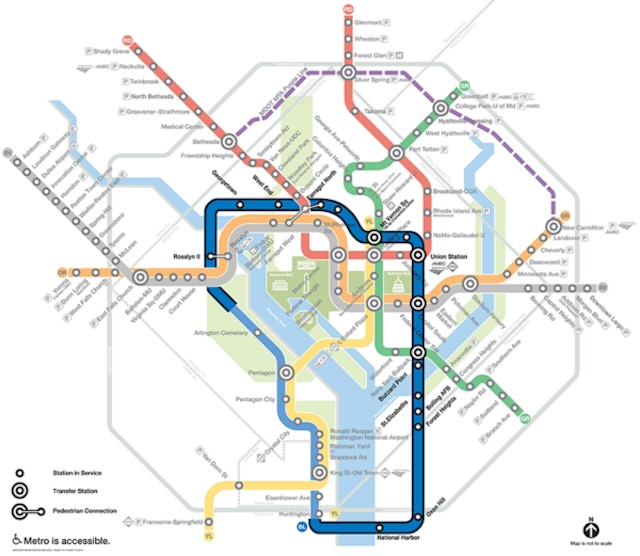Washington Metro is facing a $750 million shortfall in its 2025 budget and may have to cut service as soon as next spring. Meanwhile, its board of directors will be asked to approve an expansion of its Blue Line that will cost at least $30 billion and probably much more.
As the Antiplanner noted last July, the new line is supposedly needed because the existing Blue, Orange, and Silver lines all use the same tunnel under the Potomac River and the line can only handle 26 trains per hour. The Blue Line trains were running at capacity when the Silver Line opened, so Metro lost more Blue Line riders than it gained Silver Line riders when Blue Line trains were cut to make room for Silver Line trains.
The new Blue Line tunnel would be only a bit north of the existing tunnel and the line would continue to parallel so close to the existing line that it would actually share at least one station. In other words, it will provide no new mobility; it will merely increase the capacity of a system that should never have been built in the first place. To justify the expense of building the tunnel, Metro planners propose to extend the Blue Line south into Prince George’s County and then turn back into Virginia, making the line a circular loop.
When asked how Metro can justify spending the money to build this extension when it can’t afford to operate the trains it has, Metro staff responded that construction and operations come from two different line items in the agency’s books. But both will require tax increases, so from the taxpayer point of view this is meaningless.
The extension into Prince George’s County should worry residents of that county. Prince George’s has become a refuge from high housing prices for black and other low-income families: 60 percent of its residents are black compared with 42 percent for DC itself, less than 20 percent in Montgomery County and less than 10 percent in Arlington and Loudoun counties. Prince George’s County has the least restrictive land-use rules in the region which makes for the most affordable housing.
When the Metro Rail system was first conceived, planners proposed to build lines only to white, middle-class neighborhoods because they judged that blacks wouldn’t be able to afford to ride the trains anyway. Objections from blacks led Metro to eventually build a line into the black neighborhood of Anacostia and crossing the Anacostia River into Prince George’s County.
Far from helping black families, DC followed the extension by gentrifying the neighborhood with the help of tax-increment financing and government-funded buildings. This pushed thousands of black families out of their homes. If Metro builds a new Blue Line into Prince George’s County, it will almost certainly demand that the county do the same in order to to boost ridership by building transit-oriented developments. Residents of the area should firmly resist the Blue Line plan.
Regardless of what happens in Prince George’s County, the plan is a turkey in any case. Since the pandemic has killed the downtown Washington office market, the Blue Line trains are no longer running at capacity.
To justify the proposed expansion, Metro says it projects that ridership will increase 35 percent in the next few years. But, it admits, that projection is based on pre-pandemic data. Planners say they will make a new projection after the board decides to build the new rail line and the agency identifies a preferred alternative. How typical of a transit agency to base multi-billion-dollar decisions on data that it knows to be wrong.








